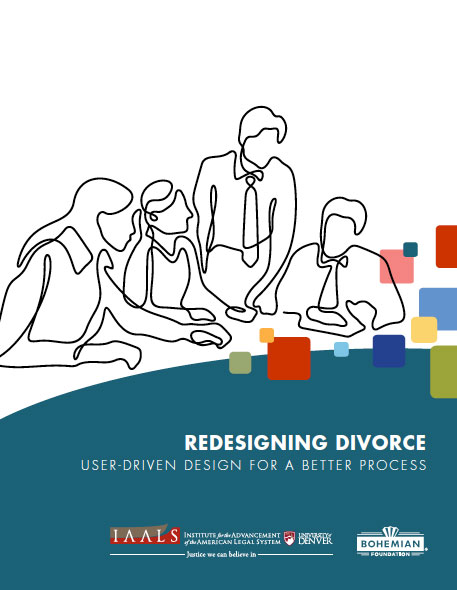New Report Incorporates User Feedback in Designing a Simpler Process for Divorce and Separation
Family courts around the country are responding to an urgent need to improve the delivery of justice for everyone who walks through their doors. However, as courts and others develop these much-needed resources and solutions, they often fail to engage those people in the feedback and reform process. IAALS’ Court Compass project is all about filling that gap by incorporating user-centric design into courts’ reform process to engage and empower litigants in creating solutions, useful and usable resources, and to help improve their trust and confidence in a system that has historically not listened to their needs. The results of IAALS’ model workshops were just released in Redesigning Divorce: User-Driven Design for a Better Process.
 With the widespread recognition that the default adversarial process is not suitable for many families—and with nearly three in four family court litigants navigating the process without an attorney—family courts are among the first to answer the call for change. And, there is a growing movement among courts and experts that calls for that change to be inclusive of the people it affects: family court litigants.
With the widespread recognition that the default adversarial process is not suitable for many families—and with nearly three in four family court litigants navigating the process without an attorney—family courts are among the first to answer the call for change. And, there is a growing movement among courts and experts that calls for that change to be inclusive of the people it affects: family court litigants.
IAALS first explored how to bring litigants into conversation with courts in our first-of-its-kind national empirical research study in 2016, Cases Without Counsel. The project explored the firsthand experience of self-represented litigants in family court, highlighting their invaluable narratives and the perspectives they have on the process and potential improvements. IAALS’ Court Compass project launched from this work, with the goal of moving from litigant input in identifying problems to actual user engagement on solutions.
Court Compass conducted a series of interactive design sprint workshops in four states—Massachusetts, Iowa, North Carolina, and Colorado—that brought self-represented litigants and other legal system stakeholders together to develop potential solutions in the divorce and separation process. Through these workshops, we gained a deeper understanding of the problems and issues that self-represented litigants experience in the family court process as well as engaged this important user group in prototyping and testing solutions that address critical issues for court users.
When given an opportunity to brainstorm solutions around the problems identified, participants centered on improvements in the following areas:
- Navigating the legal process and help with forms and appearances
- Help with personal issues, stress management, and offering more flexible hours
- Legal assistance and representation, including low- or no-cost help
- Streamlining the legal process to be more straightforward and simple
- Making the court environment less intimidating and more accessible
- Improved technology and judicial and staff interactions
IAALS previously released our practical “how to” guide to help others develop user-centered reforms through these types of interactive design sprint workshops: Listen > Learn > Lead: A Guide to Improving Court Services through User-Centered Design.
Court users are at the heart of the family and civil justice systems, and it is imperative that we, as a court and legal community, engage this user group in developing process improvements. Design sprint workshops with users—self-represented litigant or otherwise—are an important and productive means through which to solicit user feedback on existing problems and potential solutions. The Court Compass project highlights the value of these perspectives and sets a model for continued user engagement in reform.



